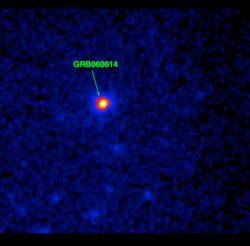 Just when you thought you’d figured out all the ways to blow up, nature reveals a new way. This latest class of explosion is called a hybrid gamma-ray burst, and it was discovered by NASA’s Swift satellite. As with most gamma-ray bursts, this explosion probably indicates the birth of a new black hole in the Universe; however, the explosion itself was different from what astronomers have seen before.
Just when you thought you’d figured out all the ways to blow up, nature reveals a new way. This latest class of explosion is called a hybrid gamma-ray burst, and it was discovered by NASA’s Swift satellite. As with most gamma-ray bursts, this explosion probably indicates the birth of a new black hole in the Universe; however, the explosion itself was different from what astronomers have seen before.
First, a little about gamma-ray bursts. They come in two varieties: long and short.
The long bursts can go on for more than two seconds (yeah, that’s the long variety), and appear to be caused when the core of a massive star collapses into a black hole. Two seconds from star to black hole.
The short variety can burst for milliseconds, and appear to be the merger of two compact objects. For example, if you have two neutron stars orbiting one another, their orbits will eventually decay to the point that they merge. Not just neutron stars, though, you could have a black hole and a neutron star.
This new explosion detected by Swift lasted for 102 seconds. That’s in the long territory; however, the light curve better matched the characteristics of a short explosion. It was like neutron stars were merging for nearly two minutes, when they should have taken only milliseconds.
Unfortunately, astronomers have no idea what caused this. “This is brand new territory; we have no theories to guide us,” noted one of the astronomers, Neil Gehrels at NASA’s Goddard Space Flight Center.
One interesting theory is that it was actually the merger of a neutron star or a black hole with a white dwarf. Instead of the instantaneous collision, the white dwarf took a full 102 seconds to be torn apart. Thanks to David Alexander Kann for additional details on this.
